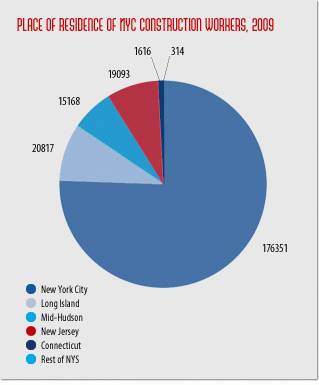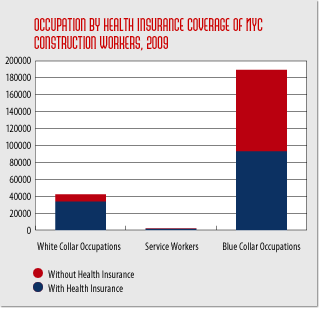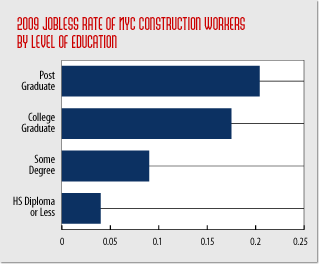
76 percent of new york city construction workers live in the five boroughs, according to new york building congress analysis
More Than Half of Construction Trades Workers are Uninsured;
Males Continue to Dominate Industry Workforce
A New York Building Congress analysis of the U.S. Census Bureau's 2009 American Community Survey found that 76 percent of New York City construction industry workers live in the five boroughs, led by residents of Queens and Brooklyn.
As of 2009, there were 233,359 men and women in the construction industry, with males accounting for 99 percent of the overall workforce. This includes both white-collar and blue-collar positions in private firms and on government payrolls. The construction trades accounted for 171,000 of these positions.
The analysis is based on personal responses to the Census Bureau survey and incorporates both union and non-union labor, as well as management positions, architects, engineers, office support and other service workers connected to the construction industry.
Of the 176,351 construction industry workers who live in New York City, 66,906 were Queens residents in 2009. Another 58,964 lived in Brooklyn, followed by 23,665 in the Bronx, 16,163 in Staten Island, and 10,653 in Manhattan.
The analysis further indicates that the construction industry remains an important source of work for recent immigrants. Non-United States citizens accounted for 41 percent of the total construction industry workforce and 48 percent of all construction trades workers. In addition, 55 percent of all respondents said they speak a language other than English in their homes. The largest percentage, after English, speak Spanish (37 percent), followed by Polish (3.5 percent) and Russian (2.4 percent).
The industry also is maintaining its reputation as a haven for middle-class employment, with 53 percent of all workers living in households with incomes between $25,000 and $100,000 annually. Just eight percent of all workers in the construction industry self-reported household earnings of less than $25,000 in 2009. Similarly, 81 percent of the construction industry respondents are considered "Not Poor" (income of more than 125 percent of the poverty level) by the Census Bureau.
The data, however, indicate that 53 percent of construction trades workers have no health insurance. By contrast, nearly 80 percent of white collar workers in the industry report having health insurance.
White Non-Hispanic men and women accounted for 96,417 of the 233,359 workers. Hispanics made up 84,958 of the total workforce, followed by Black Non-Hispanic at 30,818 and Asian workers at 18,886.
Additional demographic statistics include:
- 29 percent of the industry workforce is between 40 and 49; 27 percent are in their thirties, 19 percent are in their twenties; and 18 percent in their fifties.
- 20,817 workers lived on Long Island and 19,093 lived in New Jersey in 2009.
- 62 percent of all construction industry workers never attended college.
- Unemployment hit those with more education the hardest in 2009. The percentage of jobless college graduates was 17.5 percent and 20.5 percent for those with post-graduate degrees. By comparison, the unemployment rates for workers with high school diplomas stood at 5.4 percent in 2009.
"New York City's construction industry has been and remains a vital source of meaningful employment opportunities for recent immigrants and residents of all educational backgrounds," said New York Building Congress President Richard T. Anderson. "These data demonstrate the important role the industry plays, especially during periods of high unemployment for the City as a whole."
Mr. Anderson added, "What is troubling, however, is the large percentage of workers especially those directly involved in construction who have no health insurance at all. Given that the City's trade unions provide such coverage to all members, this is an indication that those working at non-union sites are overwhelmingly going without such benefits."
Charts and Diagrams

Source: US Bureau of the Census, 2009 American Community Survey

Source: US Bureau of the Census, 2009 American Community Survey

Source: US Bureau of the Census, 2009 American Community Survey
Raw Data
Click to download raw data file 1 (Excel)
Click to download raw data file 2 (Excel)
Click to download raw data file 3 (Excel)
Click to download raw data file 4 (Excel)
Click to download raw data file 5 (Excel)
Click to download raw data file 6 (Excel)



